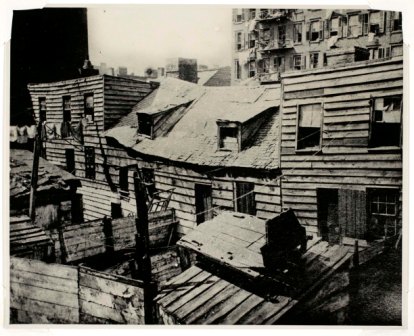
N.Y.C.’S Five Points, America’s First Toxic Industrial Ghetto
PART II of III
By: Tom Frascella March 2016
The decade immediately preceding the American Civil War is an interesting time for the Five Points area of Manhattan. By 1850 the massive wave of Irish Catholic immigrants entering the U.S. especially through the port of New York was changing the face and culture of America and New York City. In America’s poorest and most distressed urban community of the Five Points the Irish immigrant had established as the majority of the ward’s population by 1850. As a result the day to day activities within the community, official and unofficial, were largely run and controlled by this new Irish immigrant population. That is not to say however that there was not friction between the newly arrived and earlier native born residents. By 1850 politicians in New York City had begun to reach out to the ever increasing voter strength of the new immigrant community. This despite differences and clashes with established American native political, economic, religious, social and cultural standards firmly established in the more affluent parts of the city. Politics as is said makes strange bedfellows.
One distinction however for the Five Points area was because of its toxic environmental base it attracted the most distressed of the immigrant arrivals and poor native born as its residents. So from almost its very beginnings the area was a melting pot of the most distressed and vulnerable of humanity. So historically, since New York port was the gateway to the U.S. it has had a long history of waves of immigrants passing through. The poorest frequently wound up, at least temporarily in the Five Points.
We know that by the 1850’s a new immigrant group originating in southern Italy would begin arriving in the Five Points and come to be the new majority by the 1890’s. Much has been written about the Italian community that developed especially after 1900 but little is written about the earliest of Italian immigrants to this neighborhood. To be sure initially Italians were present in very small numbers. In fact in the entire decade of the 1850’s U.S. census data indicates that only about 10,000 immigrants arrived from the Italian peninsula. Many did not wind up in the Five Points as many of these immigrants were financially better off than what people might expect. So some discussion of Italian immigration and the nature of the Italian immigrant of the 1850’s to the U.S. is warranted.
First, about 20-25% of those arriving in the U.S. in the 1850’s from the Italian peninsula came to the U.S. to further already established highly skilled of professional careers. This should not be surprising as Italy has been exporting to the world highly trained, skilled and talented people throughout its existence. These were not the people who would wind up in a ghetto. In fact they would have ready access to some of the highest institutions and upper classes, professional careers and skilled work of the society of that day.
To this affluent professional group were added a new stream of “political” refugees. This group in the early 1850’s consisted of exiles fleeing the consequences of the failed Republican revolutions of 1848. In fact these immigrants are referred to by U.S. immigration officials and historians as the 1848’ers or 48ers. This group consisted of two distinct elements in exile from the republican cause. There were those who had taken part in revolutionary activities in Italy but were from the social elites and financially secure classes. In addition there were those of more modest and humble origins and means. It is the more modest Italian immigrant element that initially found itself seeking shelter in neighborhoods like the Five Points.
The Transition of Five Points to an Italian Enclave
As I have written the majority ethnic make-up of the Five Points throughout its history tended to change with changing economic situations and waves of newly arriving poor immigrants. Initially the majority of the community was made up of poor native born Americans in the 1820’s-mid 1840’s. This group was transitioned out by the major flow of poor Irish Immigrants to the U.S. in the 1830’s through the mid 1840’s. At that point the Irish had reached sufficient numbers to represent the majority. The Irish remained the dominant majority through to the mid 1880’s. Again by 1880 a new transitioning of ethnic “newcomers” the Italian immigrants had reached majority status. But the Italians had started arriving in the 1850’s and were just the next to become the dominant “ethnic majority” in the community. The transitions were frequently not without their well-publicized conflicts, which usually occurred over decades of transition.
Since the primary focus of this writing is on mass Italian and specifically Lucanian immigration which began in the 1850’s a look at the Italian transition into the Five Points is important. As stated many of the early 1850’s Italian immigrants were refugees from failed Republican revolts in various parts of the Italian peninsula. Since Italy was a divided landscape at that point these immigrants were fleeing regional political persecution rather than national. Most of those who fled to the U.S. from the Italian peninsula in the 1850’s were from northern and central Italy. They identified more regionally than nationally.
Initially in the early 1850’s southern Italian representation in the Italian immigrant community in the U.S. was under-represented. Betrayal of the republican cause by the British to Neapolitan authorities had crushed the southern revolt in 1848 before it had even gotten started. Large scale rebellion and forces did not have an opportunity to develop and be identified in the south. This in turn resulted in few southern Italians needing to flee as they remained largely unidentified to authorities and could continue to remain at home.
As previously stated many of the northern and central Italians who came in the decade of the 1850’s were men of considerable means. These had no need to seek shelter in areas like New York’s Five Points. But as Italian republican sympathizers they remained acutely aware of their less fortunate brothers. Especially those who did take up residence in areas like the Five Points.
The poor Italian immigrants who were forced by lack of resources to reside in the Five Points were socially and politically different than the majority of the Irish immigrant community of the Five Points. Of course they were all immigrants, poor and they shared Catholicism as their traditional faith. However, most Irish immigrants spoke English. The Irish were also aided in their assimilation in the U.S. because they were familiar general culture because of its similarity with English cultural norms and institutions. The poor newly arriving Italian immigrants were not so oriented or experienced and had greater difficult assimilating on arrival or even blending in.
But the major difference between the Irish immigrants and the Italians was not the above so much as that the Irish were arriving in large numbers as a population of young males and females. The Italians were few in number and almost exclusively young males many of whom had families that had remained behind in Italy when they fled or were forced into exile. With few if any economic prospects back in Ireland and large numbers of ex-pats, male and female, the Irish immigrant could look to start a new beginning/community in America. The early Italian immigrants’ world was still behind them and many looked toward going home not starting a new life here. This underscores the difference between a true immigrant community and a cluster of political refugees. The early Italians of the Five Points were political refugees and actually lacked the female resource to create an “Italian community”.
So for the Italian immigrant in NYC of the early 1850’s it was more about conserving resources and survival with an aim toward going back to their Italian regional hometowns. They were strangers in a strange land and they stood out.
Without sufficient English language skills and not understanding the culture, integration was not as important or as accessible to the poor Italian political refugee of the 1850’s. As a result Italian immigrants of the 1850’s clustered among their own for mutual support and protection not integration or a sense of community building. As early as the 1850’s you begin to see in the American press references to the “little Italys” in the Five Points. This is not however a reference to Italian immigrant communities but rather a reference to certain tenement houses within the Five Points which were rented and occupied by Italians. These overcrowded tenements were usually occupied by Italian men from a given region or town in Italy. As such they were quite close knit little male clusters but not neighborhoods or communities in the sense that we use the term today.
The statistical numbers generated by the 1860 U.S. Census concerning immigration from the Italian peninsula is quite small as it reflects the 1850’s. It is estimated that only about 10,000 Italians came to the U.S. during that decade. As I said the vast majority of these were from Northern or Central Italy and many were seeking temporary asylum from persecution from anti- republican authorities in those Italian regions. By the time of the 1860 Census few of the Italians in the U.S. would have had a political opportunity to return to Italy. The events of the later 1860 war of Unification actually occurred so fast that probably few were able to join it before it was over.
The appearance of some Southern Italians does not begin in the Five Points until the later part of the 1850’s. These early southern Italian immigrants were different than those who came before. Most of the first early southern Italian arrivals were not coming to America for political reasons. The initial arrivals were extremely poor and were at first the indirect result of the massive destruction incurred in the central rural south because of the “Great Neapolitan Earthquake” of 1858. These first southern Italians to the Five Points were refugees from a massive natural disaster.
As I have previously written the “Great Neapolitan Earthquake” did not center or significantly damage Naples or its surrounding Provence. The name misdirects modern readers as the center of the quake and its most destructive force occurred in Lucania/Basilicata. So it should not be surprising that shortly after the quake some Lucanian males seeking employment hired on as merchant seamen and found their way to America. More interesting is that young children from the rural highlands of Basilicata also began arriving in New York City at about that time.
I think it is worthwhile to look at the plight of these Lucanian children who arrived in the U.S. starting in the late 1850’s and continuing through the 1860’s. The earthquake caused many children in rural Basilicata to be orphaned. There were no formal Italian or International agencies to deal with the destruction and disaster of this magnitude. Many children were snatched up by Italian charities and church officials and placed in Italian orphanages or as cheap rural labor in other parts of Italy, Europe and even in the U.S. In essence these orphaned children were trafficked in todays’ terms but at the time there really were no other options to provide for them. While you might think that this situation was a temporary event that would improve as the communities recovered from the quake history did not play out that way in the region. The result was that this trafficking continued throughout the 1860’s. But this is a topic, Child trafficking, that I will discuss in the next and last part of the Five Points article.
Getting back to the subject of the Italian statistical presence in the Five Points in the 1850’s we are fortunate that there is some data available. This data comes primarily to us through the statistics gathered in preforming the U.S. 1860 census and the reporting in local newspapers of the time. First of all the fact that Italian immigrants were in sufficient numbers to be recorded in Five Points data already makes the statement that they were there in numbers. Census taking at the time simply would ignore populations below certain thresholds giving the appearance that they did not statistically exist. The fact that they appear in records is contrary to movies like “the Gangs of New York” which makes no reference to their presence despite the movie being set in the Five Points of 1863. This statistical fact is also contrary to the general notion that Italians began arriving in numbers much later in the 19th century.
According to a New York Times article published in 1861, the Five Points had 1665 tenements an additional 139 “underground” or cellar tenements as well as 161 known “grog” shops. It was estimated that each tenement in the area was crowded with an average 35 people per building. This means that approximately 63,000 people were living in this one ward. Of that in 1861 the largest group was as stated the Irish, with approximately 34,000. The second largest ethnic group of the Five Points, which may surprise, were the Italians with 4,648. While this is a small number relative to the Irish it represents almost half of all of the Italians who immigrated during the 1850’s. There were of course other groups living the Five Points as well, Germans approximately 2,000, and about 800 Blacks.
How bad the conditions were in America’s worst slum the Five Points is difficult for the modern reader to comprehend. Fortunately, we have many enlightening photographs by photographer Jacob Riis to help us appreciate what the 19th century immigrant faced in the Five Points. Although Riis worked in the area in the 1880’s and 1890’s conditions were if anything worse in the 1850’s and 1860’s then his photos depict. I would note that the photographs of individuals I am including are of primarily 19th century southern European and Italian immigrants. One example which I believe captures the condition of most tenement structures in the area is titled “Dens of Death’.

Copy of Jacob Riis photograph from the Five Points “Dens of death’.
Despite being trapped in conditions not only of poverty but unimaginable filth and unhealthy sanitation those that lived in the mid-19th American slums were often cast as the reason for the wretched conditions rather than the victims of it. There was initially little sympathy or sense of any larger societal obligation/responsibility for the poverty or living conditions of the slums. The New York Times article cited above for statistical purposes also mentions that the average Five Points tenement housed 35 people per building in about five rooms. The rooms were without running water or indoor plumbing. People were huddled together on makeshift cots in rooms with or without any heating. They slept surrounded by the few earthly possessions they managed to accumulate in small bundles. Again relying on some of the pictures of sleeping quarters taken by Riis for his book “How the Other Half Lives” helps get a feel for how people lived in the 19th century Five Points;
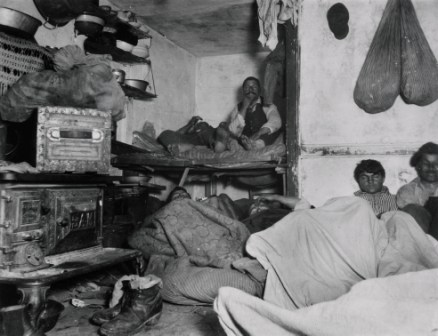
Photograph from “How the Other Half Lives” crowded bedroom with men sleeping in stacked beds.
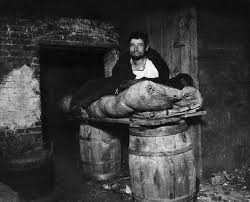
Immigrant standing beside makeshift bed supported by two wooden barrels Jacob Riis
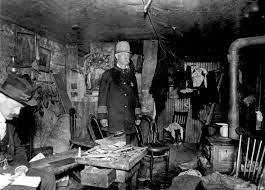
Photograph of immigrant tenement sitting in cellar room, Jacob Riis Tenement Life.
As the population of New York City exploded under the massive influx of immigrant poor the problems of, health, social depravity, and economic stagnation escalated in the Five Points beyond what could be ignored even by the 19th century affluent New Yorkers far removed from the poverty and conditions. Initially it was social reform conducted privately through primarily faith based charities. Some of the early reform efforts as a result were closely associated with moral and religious instruction as the price for shelter or food.
Even among those social reformers who held themselves out as providing for physical needs and economic opportunity for the people in these communities the general feeling was that they were attempting to save the poor from their own corruption. Often there was a feeling that the poor were not only morally but sometimes genetically inferior. For example Charles Loring Brice an ordained minister, and part of the early New York Children’s Aid Society wrote in 1854:
“The greatest danger that can threaten a country like ours, is from the existence of an ignorant, debased, and permanently poor class, in the great cities. It is still more threatening if this class be of foreign-birth, and of different habits than those of our own people. The members of it come at length to form a separate population. They embody the lowest passions and most thriftless habits of the community. They corrupt the lowest class of working poor who are around them. The expenses of police, of charities and the means of relief, arise mainly from them.”
Interestingly part of Loring’s advocacy for the poor was the establishment of piece work factories and other employment such as setting up “newsboy” lodging houses where children were encouraged to hawk newspaper for self-support. Not surprising is that eventually his “employment theories” for the “homeless” youth of New York also lead to the creation of the so-called “orphan trains”.
Homeless or orphaned children were a major problem in New York City by the 1850’s and beyond. The police of the time, 1850’s, referred to homeless children as “street rats” and later as “Arab children” because they had no permanent address. These children, many born out of wedlock or to parents that died or could not afford housing themselves existed on the streets of the Five Points. However the problem was not restricted to the Five Points and spread to other neighborhoods throughout the City. These children existed and survived as best they could on a day to day basis. The public generally regarded these children not with concern but as petty thieves that would generate a next generation of criminals and prostitutes.
In reality most orphaned or homeless children faced illness and diseases associated with poor nutrition, exposure and lack of hygiene. At best the mid-19th century provided little in the way of sound medical care even for those who could afford it. For these poor and abandoned children once ill there was little hope or places they could turn. The child mortality rate was staggering especially in the Five Points. The child or infant mortality rate routinely reached three to five times the average of the rest of the city. By way of highlighting the routine exposure I have included the Riis photo below;
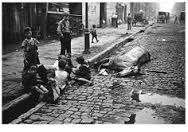
Photograph by Jacob Riis of street children playing alongside of dead horse carcass.
The homeless children literally slept in the streets and alleys of the city and many died where they slept. By way of expressing the magnitude of just the child homelessness in New York City at the time, in 1854 alone it was estimate that some 30,000 homeless children lived on the streets of the City. This out of a total city population of about 900,000 or in other words a full 3% of the total city population.
Again we can look to the photographs of Jacob Riis to give some sense of the conditions these children were living on the streets of lower Manhattan. Once again I would point out that given when these pictures were taken most of these children were southern European and mostly Italian immigrant or American born ethnic Italian.
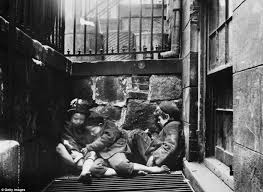
Jacob Riis photograph of “street children” huddled and sleeping in alleys.
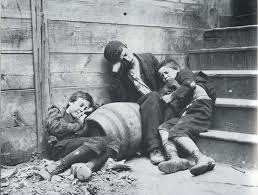
Street children sleeping in New York City
As I said one of the ways that was eventually considered appropriate to deal with the large number of homeless children was to create the “orphan train” system. The orphan trains were set up to help remove these children from the streets. The police would round them up and they would be sent temporarily to shelters. From there they were sent by train either to New England or out West. The trains had scheduled stops at which the children were herded off and selected by locals to be placed with farm families as labor. Very little if any “vetting” of the placement was done and few if any records of the placements kept. It is estimated that well over 100,000-150,000 children were dispatched in this way over about seventy years. Many of these children lost all identity or knowledge of their families or places of origin.
Another religious based reformer at about the same time was Lewis Pease who set up the Five Points House of Industry around 1854. Minister Pease ran this home for the next eight years. I will get back to the House of Industry in the next article as it also provides an interesting window on how mid-19th century America viewed the poor and homeless.
As a last remark in this article an interesting commentary in the New York Tribune from about the same time shows that certain cultural caricatures regarding early 1850’s Italian immigrants in the area were already being publicly developed. Recognizing the horrid living conditions the papers’ editorial board nevertheless described the situation in Five Points this way;
“…two well known facts: the brevity of life and the large Democratic majority at every election it is a singular fact that nearly all of our mendicants of that nationality, with the organgrinders and monkeys, live in a few houses in this region…the negro inhabitants are getting fewer every year: the place is too dirty for them…”
You can see that foreigner, criminal, democrat and organ grinder images are already seeping through the narrative as early as the mid 1850’s. Since it comes up this early in the American consciousness I will also address the origins of the Italian organ grinder and monkey stereotype in the next article as well.
© San Felese Society of New Jersey